Coursework Essay: Marijuana Legalization Effects on US Youths
VerifiedAdded on 2021/09/19
|6
|1415
|53
Essay
AI Summary
This essay examines the impact of marijuana legalization on young adults in the United States, drawing on two research articles. The introduction highlights the increased marijuana consumption and cognitive decline among young adults, particularly in states with legalized marijuana. The essay analyzes the findings of Cohn et al., which explores the relationship between substance use and mental health disorders, and Cerda et al., which investigates the effects of medical marijuana legalization on substance use, abuse, and dependence. Both articles utilize qualitative data to provide statistical details on marijuana use and user demographics. The essay synthesizes the arguments, emphasizing the potential negative consequences of legalization, including increased use and dependency, and its implications for future research. The student concludes that the essay has helped them to engage in academic communication with precision, sources, data, and logical reasoning.
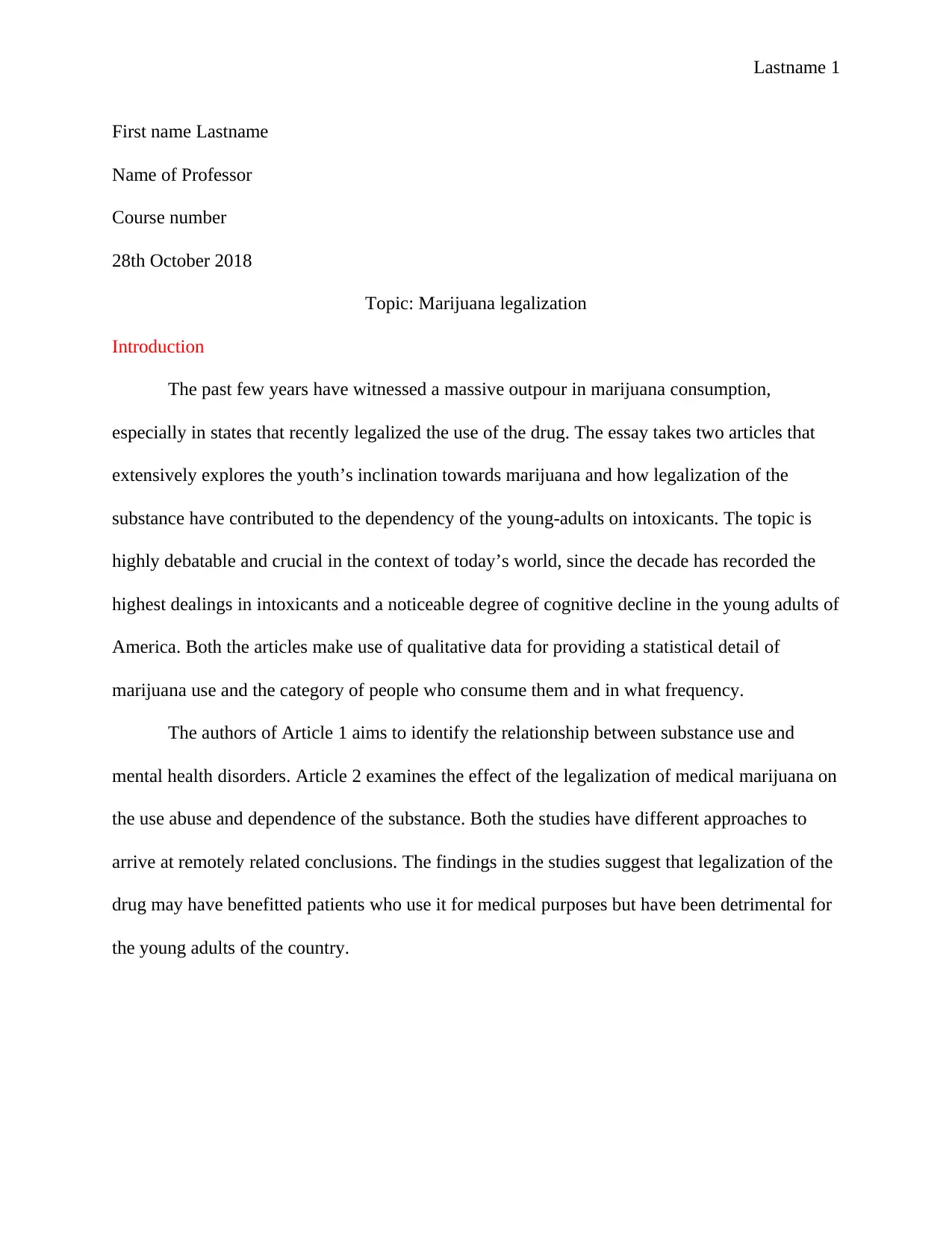
Lastname 1
First name Lastname
Name of Professor
Course number
28th October 2018
Topic: Marijuana legalization
Introduction
The past few years have witnessed a massive outpour in marijuana consumption,
especially in states that recently legalized the use of the drug. The essay takes two articles that
extensively explores the youth’s inclination towards marijuana and how legalization of the
substance have contributed to the dependency of the young-adults on intoxicants. The topic is
highly debatable and crucial in the context of today’s world, since the decade has recorded the
highest dealings in intoxicants and a noticeable degree of cognitive decline in the young adults of
America. Both the articles make use of qualitative data for providing a statistical detail of
marijuana use and the category of people who consume them and in what frequency.
The authors of Article 1 aims to identify the relationship between substance use and
mental health disorders. Article 2 examines the effect of the legalization of medical marijuana on
the use abuse and dependence of the substance. Both the studies have different approaches to
arrive at remotely related conclusions. The findings in the studies suggest that legalization of the
drug may have benefitted patients who use it for medical purposes but have been detrimental for
the young adults of the country.
First name Lastname
Name of Professor
Course number
28th October 2018
Topic: Marijuana legalization
Introduction
The past few years have witnessed a massive outpour in marijuana consumption,
especially in states that recently legalized the use of the drug. The essay takes two articles that
extensively explores the youth’s inclination towards marijuana and how legalization of the
substance have contributed to the dependency of the young-adults on intoxicants. The topic is
highly debatable and crucial in the context of today’s world, since the decade has recorded the
highest dealings in intoxicants and a noticeable degree of cognitive decline in the young adults of
America. Both the articles make use of qualitative data for providing a statistical detail of
marijuana use and the category of people who consume them and in what frequency.
The authors of Article 1 aims to identify the relationship between substance use and
mental health disorders. Article 2 examines the effect of the legalization of medical marijuana on
the use abuse and dependence of the substance. Both the studies have different approaches to
arrive at remotely related conclusions. The findings in the studies suggest that legalization of the
drug may have benefitted patients who use it for medical purposes but have been detrimental for
the young adults of the country.
Paraphrase This Document
Need a fresh take? Get an instant paraphrase of this document with our AI Paraphraser
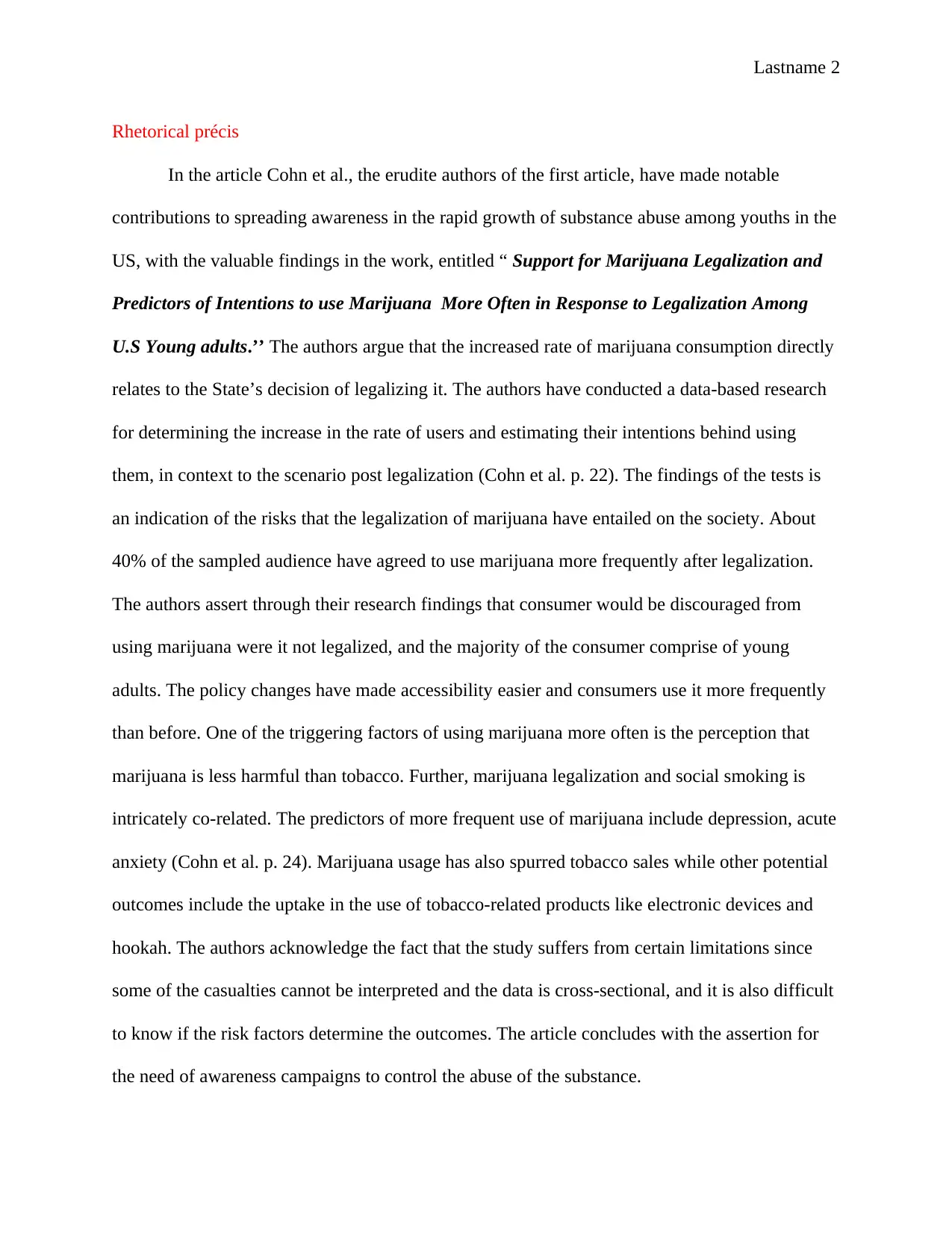
Lastname 2
Rhetorical précis
In the article Cohn et al., the erudite authors of the first article, have made notable
contributions to spreading awareness in the rapid growth of substance abuse among youths in the
US, with the valuable findings in the work, entitled “ Support for Marijuana Legalization and
Predictors of Intentions to use Marijuana More Often in Response to Legalization Among
U.S Young adults.’’ The authors argue that the increased rate of marijuana consumption directly
relates to the State’s decision of legalizing it. The authors have conducted a data-based research
for determining the increase in the rate of users and estimating their intentions behind using
them, in context to the scenario post legalization (Cohn et al. p. 22). The findings of the tests is
an indication of the risks that the legalization of marijuana have entailed on the society. About
40% of the sampled audience have agreed to use marijuana more frequently after legalization.
The authors assert through their research findings that consumer would be discouraged from
using marijuana were it not legalized, and the majority of the consumer comprise of young
adults. The policy changes have made accessibility easier and consumers use it more frequently
than before. One of the triggering factors of using marijuana more often is the perception that
marijuana is less harmful than tobacco. Further, marijuana legalization and social smoking is
intricately co-related. The predictors of more frequent use of marijuana include depression, acute
anxiety (Cohn et al. p. 24). Marijuana usage has also spurred tobacco sales while other potential
outcomes include the uptake in the use of tobacco-related products like electronic devices and
hookah. The authors acknowledge the fact that the study suffers from certain limitations since
some of the casualties cannot be interpreted and the data is cross-sectional, and it is also difficult
to know if the risk factors determine the outcomes. The article concludes with the assertion for
the need of awareness campaigns to control the abuse of the substance.
Rhetorical précis
In the article Cohn et al., the erudite authors of the first article, have made notable
contributions to spreading awareness in the rapid growth of substance abuse among youths in the
US, with the valuable findings in the work, entitled “ Support for Marijuana Legalization and
Predictors of Intentions to use Marijuana More Often in Response to Legalization Among
U.S Young adults.’’ The authors argue that the increased rate of marijuana consumption directly
relates to the State’s decision of legalizing it. The authors have conducted a data-based research
for determining the increase in the rate of users and estimating their intentions behind using
them, in context to the scenario post legalization (Cohn et al. p. 22). The findings of the tests is
an indication of the risks that the legalization of marijuana have entailed on the society. About
40% of the sampled audience have agreed to use marijuana more frequently after legalization.
The authors assert through their research findings that consumer would be discouraged from
using marijuana were it not legalized, and the majority of the consumer comprise of young
adults. The policy changes have made accessibility easier and consumers use it more frequently
than before. One of the triggering factors of using marijuana more often is the perception that
marijuana is less harmful than tobacco. Further, marijuana legalization and social smoking is
intricately co-related. The predictors of more frequent use of marijuana include depression, acute
anxiety (Cohn et al. p. 24). Marijuana usage has also spurred tobacco sales while other potential
outcomes include the uptake in the use of tobacco-related products like electronic devices and
hookah. The authors acknowledge the fact that the study suffers from certain limitations since
some of the casualties cannot be interpreted and the data is cross-sectional, and it is also difficult
to know if the risk factors determine the outcomes. The article concludes with the assertion for
the need of awareness campaigns to control the abuse of the substance.
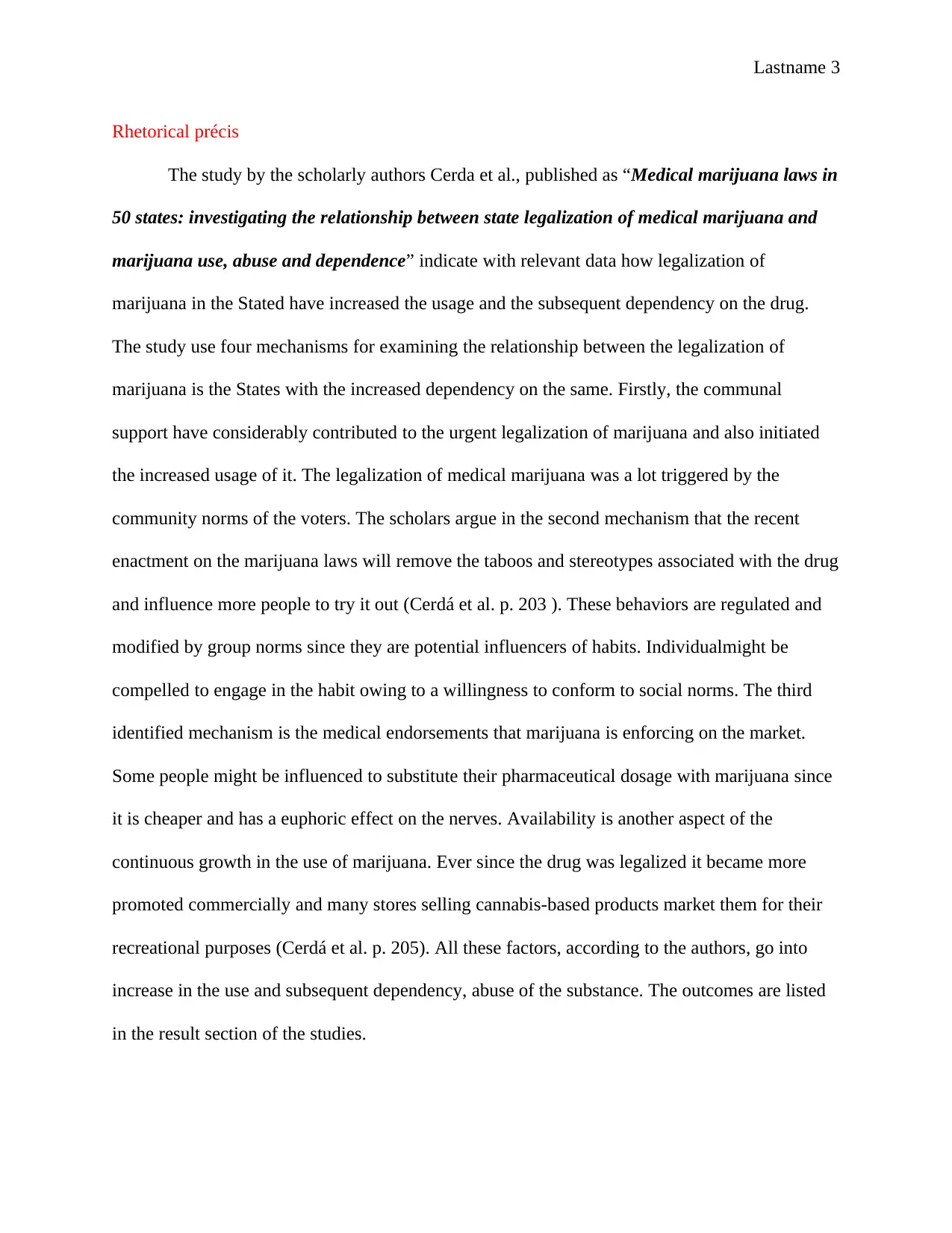
Lastname 3
Rhetorical précis
The study by the scholarly authors Cerda et al., published as “Medical marijuana laws in
50 states: investigating the relationship between state legalization of medical marijuana and
marijuana use, abuse and dependence” indicate with relevant data how legalization of
marijuana in the Stated have increased the usage and the subsequent dependency on the drug.
The study use four mechanisms for examining the relationship between the legalization of
marijuana is the States with the increased dependency on the same. Firstly, the communal
support have considerably contributed to the urgent legalization of marijuana and also initiated
the increased usage of it. The legalization of medical marijuana was a lot triggered by the
community norms of the voters. The scholars argue in the second mechanism that the recent
enactment on the marijuana laws will remove the taboos and stereotypes associated with the drug
and influence more people to try it out (Cerdá et al. p. 203 ). These behaviors are regulated and
modified by group norms since they are potential influencers of habits. Individualmight be
compelled to engage in the habit owing to a willingness to conform to social norms. The third
identified mechanism is the medical endorsements that marijuana is enforcing on the market.
Some people might be influenced to substitute their pharmaceutical dosage with marijuana since
it is cheaper and has a euphoric effect on the nerves. Availability is another aspect of the
continuous growth in the use of marijuana. Ever since the drug was legalized it became more
promoted commercially and many stores selling cannabis-based products market them for their
recreational purposes (Cerdá et al. p. 205). All these factors, according to the authors, go into
increase in the use and subsequent dependency, abuse of the substance. The outcomes are listed
in the result section of the studies.
Rhetorical précis
The study by the scholarly authors Cerda et al., published as “Medical marijuana laws in
50 states: investigating the relationship between state legalization of medical marijuana and
marijuana use, abuse and dependence” indicate with relevant data how legalization of
marijuana in the Stated have increased the usage and the subsequent dependency on the drug.
The study use four mechanisms for examining the relationship between the legalization of
marijuana is the States with the increased dependency on the same. Firstly, the communal
support have considerably contributed to the urgent legalization of marijuana and also initiated
the increased usage of it. The legalization of medical marijuana was a lot triggered by the
community norms of the voters. The scholars argue in the second mechanism that the recent
enactment on the marijuana laws will remove the taboos and stereotypes associated with the drug
and influence more people to try it out (Cerdá et al. p. 203 ). These behaviors are regulated and
modified by group norms since they are potential influencers of habits. Individualmight be
compelled to engage in the habit owing to a willingness to conform to social norms. The third
identified mechanism is the medical endorsements that marijuana is enforcing on the market.
Some people might be influenced to substitute their pharmaceutical dosage with marijuana since
it is cheaper and has a euphoric effect on the nerves. Availability is another aspect of the
continuous growth in the use of marijuana. Ever since the drug was legalized it became more
promoted commercially and many stores selling cannabis-based products market them for their
recreational purposes (Cerdá et al. p. 205). All these factors, according to the authors, go into
increase in the use and subsequent dependency, abuse of the substance. The outcomes are listed
in the result section of the studies.
⊘ This is a preview!⊘
Do you want full access?
Subscribe today to unlock all pages.

Trusted by 1+ million students worldwide
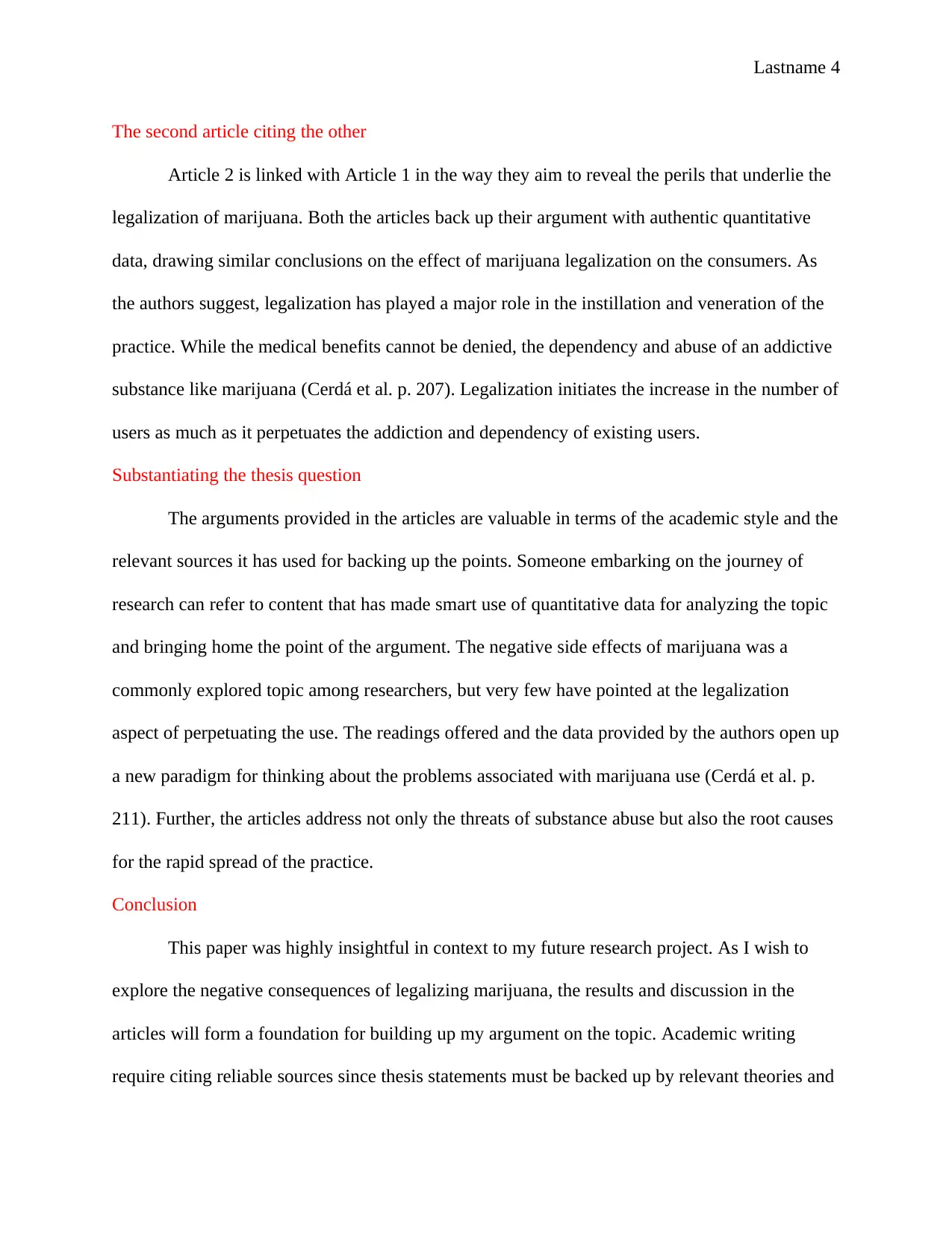
Lastname 4
The second article citing the other
Article 2 is linked with Article 1 in the way they aim to reveal the perils that underlie the
legalization of marijuana. Both the articles back up their argument with authentic quantitative
data, drawing similar conclusions on the effect of marijuana legalization on the consumers. As
the authors suggest, legalization has played a major role in the instillation and veneration of the
practice. While the medical benefits cannot be denied, the dependency and abuse of an addictive
substance like marijuana (Cerdá et al. p. 207). Legalization initiates the increase in the number of
users as much as it perpetuates the addiction and dependency of existing users.
Substantiating the thesis question
The arguments provided in the articles are valuable in terms of the academic style and the
relevant sources it has used for backing up the points. Someone embarking on the journey of
research can refer to content that has made smart use of quantitative data for analyzing the topic
and bringing home the point of the argument. The negative side effects of marijuana was a
commonly explored topic among researchers, but very few have pointed at the legalization
aspect of perpetuating the use. The readings offered and the data provided by the authors open up
a new paradigm for thinking about the problems associated with marijuana use (Cerdá et al. p.
211). Further, the articles address not only the threats of substance abuse but also the root causes
for the rapid spread of the practice.
Conclusion
This paper was highly insightful in context to my future research project. As I wish to
explore the negative consequences of legalizing marijuana, the results and discussion in the
articles will form a foundation for building up my argument on the topic. Academic writing
require citing reliable sources since thesis statements must be backed up by relevant theories and
The second article citing the other
Article 2 is linked with Article 1 in the way they aim to reveal the perils that underlie the
legalization of marijuana. Both the articles back up their argument with authentic quantitative
data, drawing similar conclusions on the effect of marijuana legalization on the consumers. As
the authors suggest, legalization has played a major role in the instillation and veneration of the
practice. While the medical benefits cannot be denied, the dependency and abuse of an addictive
substance like marijuana (Cerdá et al. p. 207). Legalization initiates the increase in the number of
users as much as it perpetuates the addiction and dependency of existing users.
Substantiating the thesis question
The arguments provided in the articles are valuable in terms of the academic style and the
relevant sources it has used for backing up the points. Someone embarking on the journey of
research can refer to content that has made smart use of quantitative data for analyzing the topic
and bringing home the point of the argument. The negative side effects of marijuana was a
commonly explored topic among researchers, but very few have pointed at the legalization
aspect of perpetuating the use. The readings offered and the data provided by the authors open up
a new paradigm for thinking about the problems associated with marijuana use (Cerdá et al. p.
211). Further, the articles address not only the threats of substance abuse but also the root causes
for the rapid spread of the practice.
Conclusion
This paper was highly insightful in context to my future research project. As I wish to
explore the negative consequences of legalizing marijuana, the results and discussion in the
articles will form a foundation for building up my argument on the topic. Academic writing
require citing reliable sources since thesis statements must be backed up by relevant theories and
Paraphrase This Document
Need a fresh take? Get an instant paraphrase of this document with our AI Paraphraser

Lastname 5
verifiable research findings in the past for credibility. This assignment has taught me how to
engage in academic communication with exact precision, sources, data and logical reasoning
(Cerdá et al. p. 212). I have gathered the information that apart from being theoretically strong
and logically sensible, it is important that an academic writer is consistent and simple, for
targeting the readers from all areas.
verifiable research findings in the past for credibility. This assignment has taught me how to
engage in academic communication with exact precision, sources, data and logical reasoning
(Cerdá et al. p. 212). I have gathered the information that apart from being theoretically strong
and logically sensible, it is important that an academic writer is consistent and simple, for
targeting the readers from all areas.
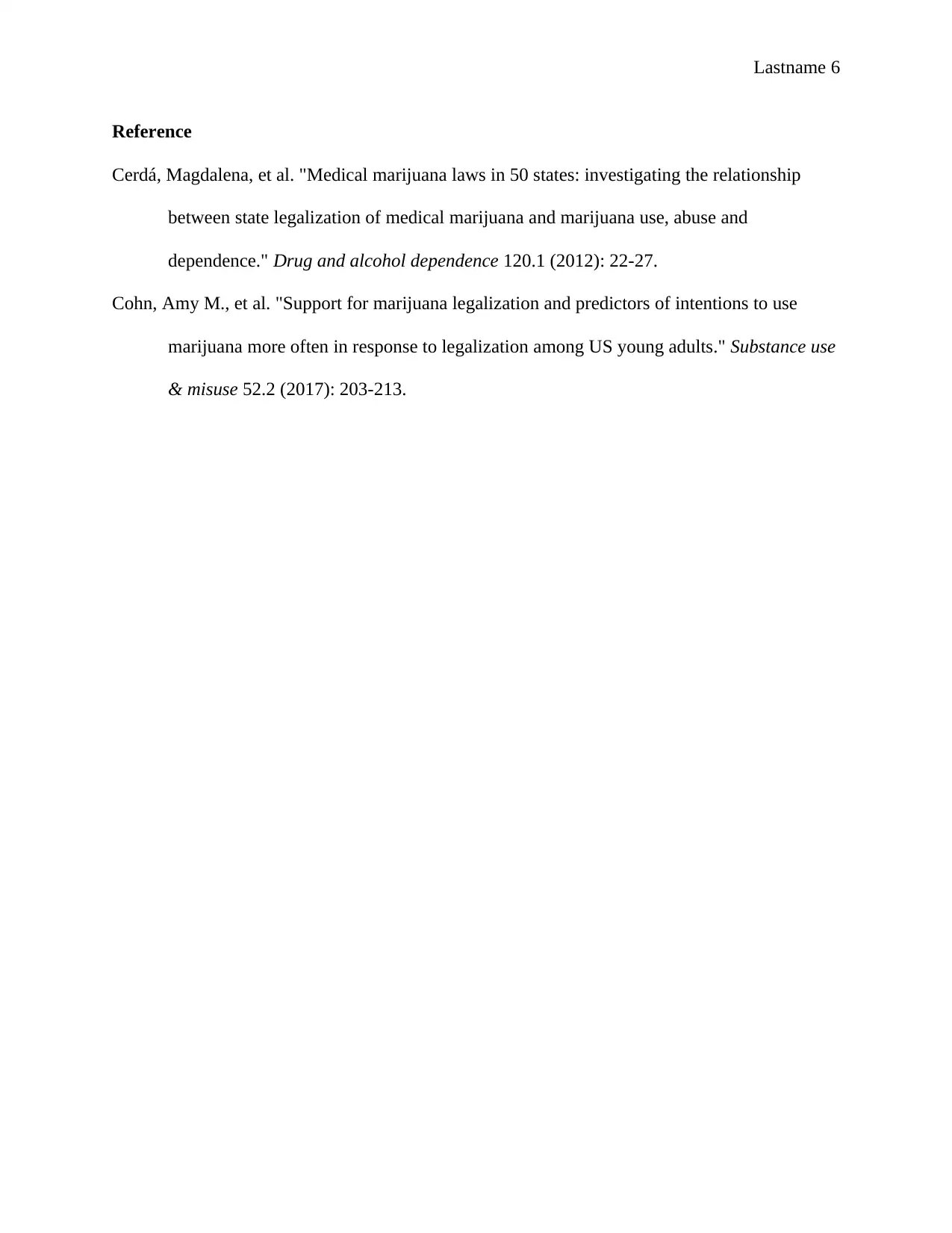
Lastname 6
Reference
Cerdá, Magdalena, et al. "Medical marijuana laws in 50 states: investigating the relationship
between state legalization of medical marijuana and marijuana use, abuse and
dependence." Drug and alcohol dependence 120.1 (2012): 22-27.
Cohn, Amy M., et al. "Support for marijuana legalization and predictors of intentions to use
marijuana more often in response to legalization among US young adults." Substance use
& misuse 52.2 (2017): 203-213.
Reference
Cerdá, Magdalena, et al. "Medical marijuana laws in 50 states: investigating the relationship
between state legalization of medical marijuana and marijuana use, abuse and
dependence." Drug and alcohol dependence 120.1 (2012): 22-27.
Cohn, Amy M., et al. "Support for marijuana legalization and predictors of intentions to use
marijuana more often in response to legalization among US young adults." Substance use
& misuse 52.2 (2017): 203-213.
⊘ This is a preview!⊘
Do you want full access?
Subscribe today to unlock all pages.

Trusted by 1+ million students worldwide
1 out of 6
Related Documents
Your All-in-One AI-Powered Toolkit for Academic Success.
+13062052269
info@desklib.com
Available 24*7 on WhatsApp / Email
![[object Object]](/_next/static/media/star-bottom.7253800d.svg)
Unlock your academic potential
Copyright © 2020–2025 A2Z Services. All Rights Reserved. Developed and managed by ZUCOL.





